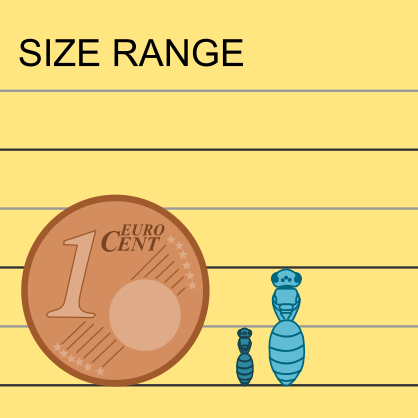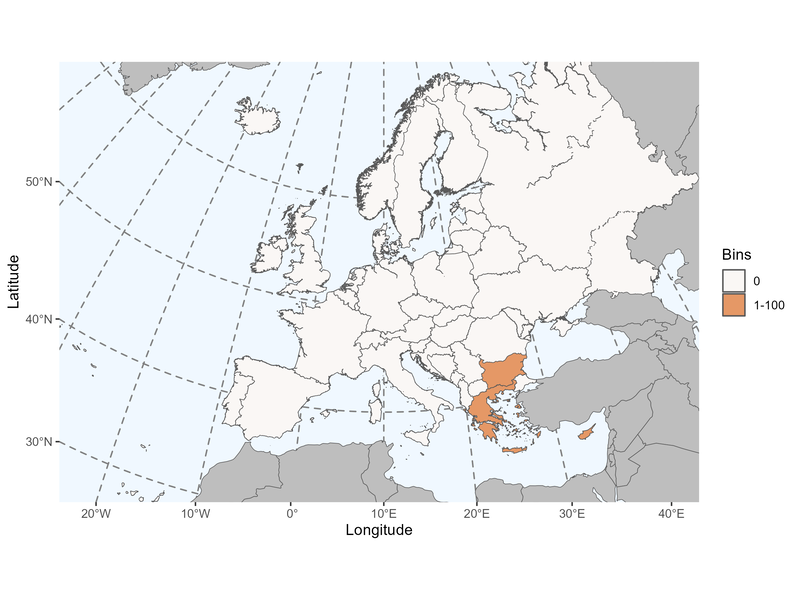Author: Lepeletier, 1841
|
Type species: Ancyla oraniensis Lepeletier, 1841, monobasic.
Synonyms: Plistotrichia Morawitz, 1874. |
Clade: Anthophila
Family: Apidae SubF: Anthophorinae Tribe: Ancylini |
|
Distinctive traits
|
Pictures of distinctive traits (yet to come, if you have some, please contact us.)
|
Morphologically close genera and how to distinguish them:
Tarsalia, Eucera, Amegilla & Anthophora species have elongated mouthparts (glossa and palpi) and a protuberant clypeus.
- Ancyla - Tarsalia, Eucera, Amegilla & Anthophora
Tarsalia, Eucera, Amegilla & Anthophora species have elongated mouthparts (glossa and palpi) and a protuberant clypeus.
General comments on Ancyla species identification
Species identification criteria include mesosoma pilosity and clypeus colour patterns.
Species identification criteria include mesosoma pilosity and clypeus colour patterns.
Sorry, but the species identification tool is not yet available for Ancyla.
Please check the reference(s) at the bottom of the page for traditional keys.
Please check the reference(s) at the bottom of the page for traditional keys.
List of the 5 Ancyla species found in Europe (Ghisbain et al. 2023):
Ancyla asiatica Friese, 1922
Ancyla cretensis Friese, 1902
Ancyla holtzi Friese, 1902
Ancyla nigricornis Friese, 1902
Ancyla orientalica Warncke, 1979
Ancyla asiatica Friese, 1922
Ancyla cretensis Friese, 1902
Ancyla holtzi Friese, 1902
Ancyla nigricornis Friese, 1902
Ancyla orientalica Warncke, 1979
References with identification keys for some of the species:
- Warncke, K. 1979. Beiträge zur Bienenfauna des Iran : 10. Die Gattung Ancyla LEP., mit einer Revision der Bienengattung Ancyla LEP. Boll. Mus. Civ. Stör. Nat., Venezia 30 : 183-19
Page contributors:
You noticed a mistake? You have a suggestion to improve this page?
Don't keep it to yourself, contact us and become a contributor to IDmyBee!
References used to write this page:
- Adrien Perrard (Dec. 2023)
- Adrien Perrard (Dec. 2019)
You noticed a mistake? You have a suggestion to improve this page?
Don't keep it to yourself, contact us and become a contributor to IDmyBee!
References used to write this page:
- Bossert, S., E. Murray, E.A.B. Almeida, S. Brady, B. Blaimer, B.N. Danforth (2018). Combining transcriptomes and ultraconserved elements to illuminate the phylogeny of Apidae. Molecular Phylogenetics and Evolution 130 (2019): 121–131
- Ghisbain, G., Rosa, P., Bogusch, P., Flaminio, S., Le Divelec, R., Dorchin, A., Kasparek, M., Kuhlmann, M., Litman, J., Mignot, M., Müller, A., Praz, C., Radchenko, V.G., Rasmont, P., Risch, S., Roberts, S.P.M., Smit, J., Wood, T.J., Michez, D. & Reverte, S. (2023). The new annotated checklist of the wild bees of Europe (Hymenoptera: Anthophila). Zootaxa, 5327(1), 1-147.
- Michener, C.D. 2007. The Bees of the World, 2nd Edition. The John Hopkins University Press, Baltimore.
- Michez D., Rasmont P., Terzo, M., Vereecken, N. 2019. Abeilles d'Europes. Hymenoptères d'Europes, Volume 1. N.A.P. Editions.
- Nieto, A., Roberts, S. P., Kemp, J., Rasmont, P., Kuhlmann, M., García Criado, M., ... & Michez, D. 2014. European red list of bees. Luxembourg: Publication Office of the European Union, 98. (IUCN 2014)
- Rasmont, P., Devalez, Jelle, Pauly, A., Michez, D. & Radchenko, V.G. 2017. Addition to the checklist of IUCN European wild bees (Hymenoptera: Apoidea). Annales de la Société entomologique de France 53: 17-32.



